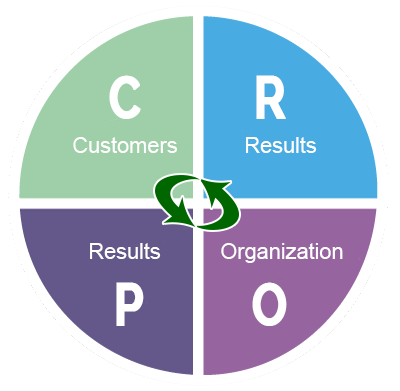We would like to offer best services, in order to exceed and meet our Customer needs with high level of satisfaction. We want to provide the highest quality and competence in process excellence growing together.
We exist thanks to our Customers and we are very grateful to them for what we are today. Our intent is to strive your organization for excellence.
Company development cycle (CPOR)
According to our modus operandi, the Voice of the Customer ("C") triggers a virtuous cycle to "pull" processes ("P"), through which the organization ("O") and the development of talents and resources leads to the achievement of concrete financial results ("R").
-
Customers
- Value Generation
- Competitiveness
- Product and service quality improvement
-
Processes
- Process engineering and standardization
- Process simplification and prioritization
- Process governance and sustainability
-
Economic Results
- Costs reduction
- Productivity
- Financial benefits increasing
-
Organization
- Efficiency
- Involvement and empowerment
- Resources and talents optimization
- Best practices adoption
Process evolution
The activities we propose represent the path of the processes towards excellence. The cycle of improvement is developed through four phases: streamlining, stabilization, automation and innovation. Our organization is able to lead and support our customers through the different stages of this process, through intercompany sessions, workshops, projects, training, OJT, project management and other specific events.
Improvement phases
The understanding of the current state is the starting point for "knowing" the process. Is achieved through the mapping of flows and a careful process snapshot as "it is", taking awareness of strengths and weaknesses. This step is vital to determine the needs to be addressed and the objectives to be achieved through the improvement phase
The simplification of the process is the first step of improvement and aims to make a simple and streamlined process, through the identification and elimination of all that is superfluous and therefore "waste" (non-value added activities). This is accomplished through the application of techniques and methodologies coming from Lean Thinking approach
The stabilization phase wants to analyze the process in term of variability and, after an accurate analysis of cause and effect of the determining factors, to implement specific actions for the reduction of output variability. This optimization phase, coming from the methodologies Total Quality and Six Sigma, aims to a more stable process able to generate fewer defects. The integration and implementation of the last two phases produces the methodological approach called Lean Six Sigma
The next phase “automation”, is the creation of tools, standardized or automated procedures able to ensure a reduction of the commitment of resources required for the audit, execution and maintenance of the processes. The creation of specific tools for data management could be a potential in term of development, business improvement and therefore competitiveness. The final goal is to achieve a process "self-controlled"
The innovation phase is linked to the discovery of talents, made possible through the previous steps, and through the application of advanced methodologies from Lean Thinking, Design For Six Sigma, Value Engineering and from Inventing techniques linked to Marketing and Business strategies. This is 'the more evolved step' for an organization that transforms “continuous” improvement in a progressive innovation over time





